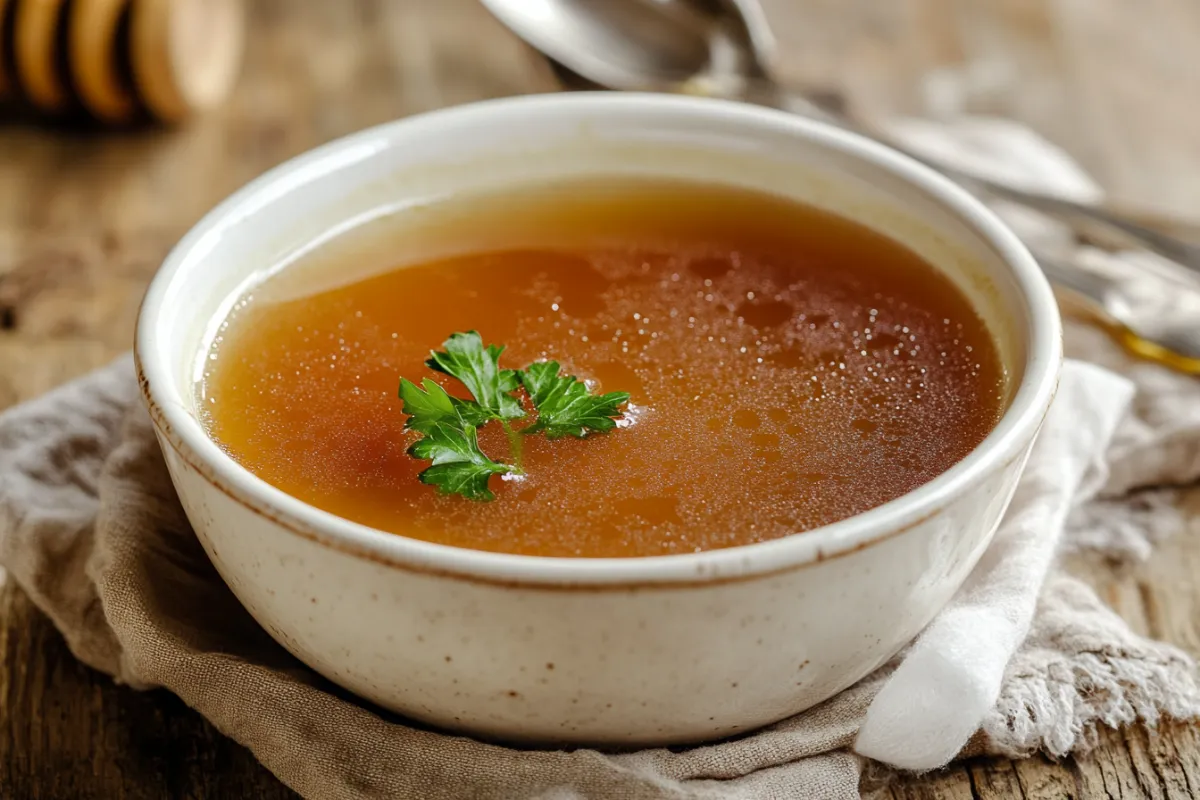What is the Difference Between Broth and Consommé?
In the culinary world, broth and consommé are two of the most fundamental liquids used in cooking. While they may seem interchangeable to the untrained eye, they differ significantly in terms of preparation, flavor, and usage. Understanding these differences can help improve your cooking, especially when crafting soups, sauces, and stews. In this guide, we will explore every detail about broth and consommé, compare them, and provide in-depth instructions on how to prepare each of these essential liquids at home.
Understanding Broth: Origins and Essentials
Broth is one of the oldest cooking liquids in the world. Historically, broth was a simple and efficient way to extract nutrients and flavors from leftover meat, vegetables, and bones. Early civilizations recognized the value of simmering ingredients in water to create a warm, nourishing dish, which could feed many people while using minimal resources.
What Exactly is Broth?
At its core, broth is made by simmering meat, vegetables, and sometimes bones in water. The primary goal is to extract the flavor and nutrients from these ingredients into the water, resulting in a savory liquid. Broth is often the base for many soups, sauces, risottos, and stews, making it an indispensable part of cooking. It can be enjoyed on its own or used as a foundational ingredient for more complex dishes.
Broth Ingredients and Variations
The basic ingredients for making broth are quite simple, but slight variations in ingredients can produce entirely different types of broths:
- Meat: Chicken, beef, pork, and fish are the most common meats used in broth. Chicken broth, for example, is light and versatile, making it perfect for many dishes.
- Vegetables: Carrots, onions, celery, and garlic are frequently added to the broth to enhance its flavor. These vegetables are usually simmered until soft.
- Bones: Adding bones to the broth not only increases its nutritional value (especially in terms of collagen) but also gives the liquid a deeper, richer flavor.
- Herbs and Spices: Common additions include bay leaves, thyme, rosemary, and black peppercorns. These ingredients can be tailored to personal taste preferences.
- Water: The quantity of water used plays a major role in determining the strength of the broth. More water results in a lighter broth, while less water makes a richer and more concentrated liquid.
Different Types of Broth
Depending on the ingredients used, there are various types of broth:
- Chicken Broth: Mild and light, made primarily with chicken meat and bones. It is often used as the base for soups such as chicken noodle soup.
- Beef Broth: Richer and heartier, beef broth is made from simmering beef bones and meat. This broth is used in stews and gravies for added depth of flavor.
- Vegetable Broth: Ideal for vegetarians and vegans, this broth is made by simmering a mixture of vegetables. It’s commonly used in dishes like vegetable soups or as a base for grain cooking.
- Fish Broth: Light and aromatic, fish broth is made by simmering fish bones and heads with herbs. This broth is frequently used in seafood stews and bisques.
Broth is relatively easy to prepare and can be made with leftover ingredients, making it a kitchen staple for many home cooks.
What is Consommé?
Consommé, on the other hand, is a more sophisticated liquid, known for its clarity and depth of flavor. Its creation involves an extra step beyond broth, known as clarification. This process removes impurities and fat, leaving behind a crystal-clear liquid that is often served in fine dining settings.
History and Origins of Consommé
The origins of consommé date back to medieval times when chefs began refining the art of soup-making. In French cuisine, consommé was regarded as a symbol of culinary skill because of the careful process needed to achieve a clear and flavorful result. It is most closely associated with French culinary traditions, but today it is used worldwide in both high-end and home cooking.
How is Consommé Made?
Consommé is made from a rich broth or stock, but the main difference comes from the clarification process. The key to this process is the use of egg whites, which act as a filter to trap impurities. Here is how consommé is traditionally prepared:
- Starting with Broth or Stock: The base of consommé is usually a well-prepared broth or stock. It can be made from beef, chicken, or vegetables.
- Whisking Egg Whites: Raw egg whites are whisked together with ground meat and vegetables. This mixture is then added to the hot broth.
- Simmering to Form a “Raft”: As the mixture heats up, the egg whites coagulate and rise to the top of the broth, forming a “raft” that traps impurities.
- Straining the Liquid: Once the raft has formed, the liquid beneath is strained through cheesecloth or a fine mesh sieve. The result is a perfectly clear and intensely flavorful consommé.
Unlike broth, consommé is known for its purity and intensity of flavor, often served as an elegant starter at formal meals.
Key Differences Between Broth and Consommé
Although both broth and consommé are savory liquids used in cooking, there are several major differences between them:
- Appearance: Broth is typically cloudy and contains small particles of meat, vegetables, and fat, while consommé is crystal-clear.
- Ingredients: Both use similar ingredients, but consommé undergoes the clarification process, which involves the use of egg whites to remove impurities.
- Flavor: Consommé is more concentrated and flavorful than broth. This is due to its reduction and clarification, which intensifies the taste.
- Texture: While broth can be slightly gelatinous (especially if bones are used), consommé has a silky, smooth texture.
- Usage: Broth is a base for many everyday dishes, while consommé is often served as a refined appetizer or used in gourmet dishes.
These differences are crucial when deciding which liquid to use in your recipes. Broth is more versatile and forgiving, while consommé requires precision and care.
Clarification Process in Consommé: A Deeper Dive
The clarification process is what sets consommé apart from other broths and stocks. This process uses protein—usually egg whites—to remove fat and impurities. Here’s a step-by-step breakdown of how clarification works:
- Whisking Egg Whites and Mirepoix: Egg whites are beaten until they form soft peaks. To this mixture, finely chopped mirepoix (a mixture of carrots, celery, and onions) is added, along with ground meat for extra richness. This mixture is known as the clarification mixture.
- Adding to the Broth: The clarification mixture is slowly stirred into a hot broth, which should be kept at a low simmer.
- Forming the Raft: As the broth heats up, the egg whites begin to coagulate, trapping impurities. This forms a solid raft on the surface of the liquid.
- Simmering Gently: The broth is left to simmer under the raft for about 30–40 minutes. During this time, the raft absorbs all the fat and impurities from the broth.
- Straining: Finally, the broth is carefully strained through cheesecloth, leaving behind a crystal-clear consommé.
This process not only removes particles but also intensifies the flavor of the broth, resulting in a pure and elegant consommé.
Different Types of Consommé
Just as there are variations in broth, there are also different types of consommé based on the ingredients used:
- Beef Consommé: Made from beef stock, beef consommé is rich and savory, often served as a stand-alone soup or with small garnishes such as truffles or vegetables.
- Chicken Consommé: Lighter than beef consommé, this is made from chicken broth and is often served as a clear soup.
- Vegetable Consommé: Made without any meat, this consommé is perfect for vegetarians. It features a delicate flavor from the vegetables used.
- Double Consommé: This is consommé that has been reduced by half, making it even more concentrated and rich in flavor. Double consommé is often used in sauces and as a base for more complex dishes.
Nutritional Differences Between Broth and Consommé
From a nutritional standpoint, both broth and consommé have their benefits, though they differ slightly in their composition:
- Broth:
- Rich in collagen if bones are used.
- Contains moderate levels of fat, depending on the meat and bones used.
- High in minerals and vitamins from the meat and vegetables.
- Hydrating and soothing, making it a staple in many cultures for treating colds and illnesses.
- Consommé:
- Lower in fat because the clarification process removes most of the fat.
- More concentrated in flavor and nutrients, so a smaller amount packs more of a punch.
- Clearer and more refined, making it a lighter choice for those looking to cut down on fat while still enjoying rich flavor.
While both are healthy choices, consommé is often considered more refined due to its clarity and lower fat content, making it ideal for lighter meals.
How to Use Broth and Consommé in Cooking
Both broth and consommé have numerous uses in the kitchen. Here are some common applications:
Broth:
- Soups and Stews: Broth is the base for countless soups, from simple vegetable soups to complex stews.
- Cooking Grains: Use broth instead of water to cook grains like rice, quinoa, or barley for added flavor.
- Sauce Base: Broth adds depth to sauces and gravies, making it a versatile ingredient for roasts and braises.
Consommé:
- Fine Dining Soups: Consommé is often served as an elegant appetizer, garnished with fresh herbs, vegetables, or even truffles.
- Base for Sauces: Because of its intense flavor, consommé can be used as a base for creating rich, flavorful sauces.
- Light Appetizers: Consommé is often served as a light starter, allowing diners to enjoy a refined and flavorful dish without feeling full before the main course.
FAQs About Broth and Consommé
1. What is the main difference between broth and consommé?
The main difference lies in the clarity and concentration of flavor. Broth is cloudy and milder, while consommé is crystal-clear and has a more intense flavor due to the clarification process.
2. Is consommé healthier than broth?
Consommé is lower in fat because the clarification process removes most of the fat. It’s also more concentrated, so a smaller serving provides the same flavor impact. Broth, however, is richer in collagen if bones are used.
3. Can you use broth as a substitute for consommé?
Yes, broth can be used as a substitute in most recipes, though the final dish will be cloudier and less concentrated in flavor. In high-end dishes, consommé’s clarity and concentration are preferred.
4. How long does it take to make consommé?
Consommé takes longer to make than broth because of the additional clarification step. The entire process can take 4–6 hours, depending on the size of the batch and the complexity of the recipe.
5. Can I freeze consommé?
Yes, consommé can be frozen and used later. It’s best to freeze it in small portions so you can easily thaw and use it as needed.
Conclusion
In conclusion, both broth and consommé play vital roles in the culinary world. While broth is versatile, easy to make, and serves as the backbone for many dishes, consommé stands out for its refinement, clarity, and concentrated flavor. Understanding the differences between these two liquids allows cooks to choose the right one for each recipe, enhancing the final dish’s flavor and texture. Whether you’re cooking a comforting stew or preparing a fine dining appetizer, knowing when to use broth or consommé will take your cooking to the next level.
If you’re interested in exploring more culinary insights, check out the ultimate guide to chocolate or dive into other culinary techniques on Lolyta Recipes.

